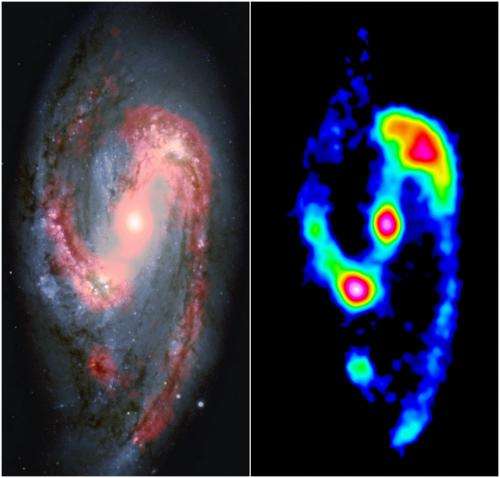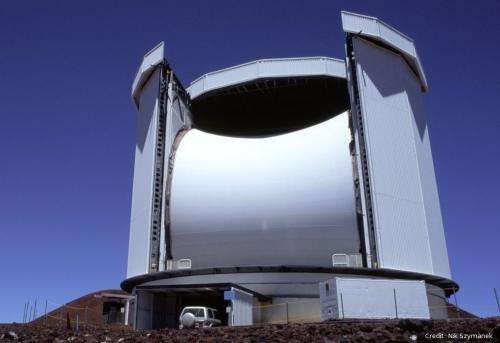Dusty stellar nurseries from the dark side of a galaxy

(Phys.org) -- A new multi-million pound camera is producing its first detailed pictures of our neighboring galaxies, revealing vast, dusty stellar nurseries where the next generation of stars is being created. "This exquisite image from the galaxy M66 in the constellation Leo is exactly the promising start we were hoping for," said Dr. Stephen Serjeant, the team's co-leader from The Open University. "This is a wonderfully exciting taste of things to come."
When looking up at the Milky Way, an irregular pattern of dark regions obscures the light of the stars. The dark patches are caused by clouds of dust trailing through the spiral arms and blocking out the starlight; they contain vast stellar nurseries where the next generation of stars is being created. These dark lanes are not exclusive to the Milky Way, but can be found in all spiral galaxies.
Although they are dark to our eyes, these dust lanes actually glow brightly at sub-millimetre (sub-mm) wavelengths. A revolutionary new camera, called SCUBA-2, is ideally suited to detect this long-wavelength dust emission. It is mounted on the world's largest sub-mm telescope, the 15-metre James Clerk Maxwell Telescope (JCMT) in Hawaii, and is the most powerful camera ever developed for observing sub-mm wavelengths. It detects light waves 1000 times longer than human eyes can see.

This image promises to be the first of many stunning results from the JCMT Nearby Galaxy Legacy Survey (NGLS). The main aim of the survey is to understand how the broader environment of a galaxy affects its gas and dust content. For example, galaxies in dense clusters can lose their gas and dust through interactions with other galaxies in the cluster or simply by the head wind they feel while moving through the hot gas trapped inside the cluster. The NGLS is an international collaboration led by astronomers from Canada, the Netherlands, and the United Kingdom which is using SCUBA-2 to observe 150 galaxies in the local universe.
The NGLS team has spent much of the last five years studying molecular hydrogen emission using another instrument on the JCMT. "It is very exciting to now see the first results from the SCUBA-2 side of our program starting to come in," says Professor Christine Wilson, the Principal Investigator from McMaster University in Canada. "We have a unique sample of galaxies that we are studying and having SCUBA-2 data will let us measure their gas and dust content. Gas and dust usually go hand-in-hand in galaxies, but from time to time, you find a surprise."
Provided by Joint Astronomy Centre










.jpg)









